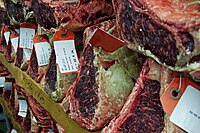
Photo from wikipedia
The role of moisture evaporation in the taste attributes of dry- and wet-aged beef was determined in this study. A total of 30 striploins (longissimus lumborum) were dry or wet aged… Click to show full abstract
The role of moisture evaporation in the taste attributes of dry- and wet-aged beef was determined in this study. A total of 30 striploins (longissimus lumborum) were dry or wet aged for 28 days and analyzed for moisture content, taste-active compounds [free amino acids (FAAs), inosine 5'-monophophate (IMP), and reducing sugars], and taste attributes by an electronic tongue. After the completion of aging process, higher amounts of FAAs and reducing sugars were found in dry-aged beef (P < .05) in negative correlations with moisture content (r2 = -0.9 and - 0.9, respectively), which were not detected in wet-aged beef. However, the different taste attributes of dry- and wet-aged beef were observed by the electronic tongue from day 14, whereas their moisture content was significantly different only at day 28. Consequently, although the moisture evaporation during dry aging process contributed to the increased flavor of dry-aged beef, there are other factors affecting flavor development including microbial activity on the surface crust.
Journal Title: Meat science
Year Published: 2019
Link to full text (if available)
Share on Social Media: Sign Up to like & get
recommendations!